2024 AIChE Annual Meeting
Effects of X-Ray Irradiation on Self-Regulating Hyperthermia Magnetic Nanoparticles of Gadolinium Silicide
Gd5Si4 nanoparticles were prepared using the procedure reported in [1]. An X-RAD 225XL Precision X-ray system was used to irradiate the sample for 5 hours at a dose rate of approximately 120 Gy/min (ASTM E 1026-04). This study produced results that showcased observable effects on the magnetic properties of the material when exposed to X-ray irradiation. XRD analysis was carried out on the samples before and after irradiation, and there were no observable changes in the crystalline structure.
A vibrating sample magnetometer (VSM, Quantum Design, 3 T VersaLab) was used to measure the magnetization (M) of Gd5Si4 with applied magnetic fields ranging from -3 T to 3 T, and magnetization was measured from 200 K to 400 K at an applied magnetic field of 100 Oe. Fig.1(a) shows M-T data from 200K to 400K before irradiation and Fig.1(b) shows M-T data after irradiation. A small change is seen in the transition temperature of 1K-3K, and a change in magnetization (M) of the samples is present. Fig.2(a) and Fig.2(b) present hysteresis graphs at 300K. Change in saturation is present in post-irradiation graphs with a decrease in magnetization in irradiated samples. These results indicate that irradiation affects magnetic hyperthermia treatment by changing the magnetization of the samples and the transition temperature without having an effect on structural properties.
Acknowledgments: Authors thank the funding from the Commonwealth Cyber Initiative Grant, NSF #2304513 and #2349694.
References:
[1] Z. Boekelheide, Z. A. Hussein, S. M. Harstad, A. A. El-Gendy and R. L. Hadimani, "Gd5Si4 Micro- and Nano-Particles for Self-Regulated Magnetic Hyperthermia," in IEEE Transactions on Magnetics, vol. 53, no. 11, pp. 1-4, Nov. 2017, Art no. 5400204, doi: 10.1109/TMAG.2017.2708688.
[2] A. A. El-Gendy et al., "Ferromagnetic Gd5Si4 Nanoparticles as T2 Contrast Agents for Magnetic Resonance Imaging," in IEEE Magnetics Letters, vol. 8, pp. 1-4, 2017, Art no. 1507504, doi: 10.1109/LMAG.2017.2728503.
